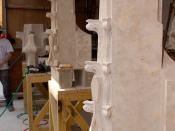Walter Benjamin - The Work of Art in the Age of Mechanical Reproduction
Summary
Works of art have always been reproducible, through imitation. Mechanical reproduction characterizes a new period in reproduction, with new limits and repercussions. Each new technology employed in the production or reproduction of art increased the speed with which they could be done so. Lithography allowed for multiple images from one original, keeping up with the happenings of everyday life, and then photography allowed the artist to produce at the same speed as speech.
All reproductions of art lack the original's presence in a specific time and place, which is the basis for authenticity. The mechanical reproduction is more independent from the original in that the producer has many choices in lighting, lens, angle, scale etc. The mechanical reproduction has the advantage of being able to place the image within situations inaccessible to the original.
Once authenticity and originality are confused, the authority of the object becomes confused as well.
The technique of mechanical reproduction separates it from the traditions of the original. The multitude of copies overwhelms the uniqueness of the original, yet upon seeing the reproduction the viewer is referred automatically to the original (if they have knowledge of the original).
The contemporary decay of the aura is due to two circumstances. First, the urge to bring objects closer both spatially and humanly. Secondly, the attempt to overcome the uniqueness of reality by accepting and embracing its reproduction.
Tradition calls for the uniqueness of a work of art. With the development of photography and the rise of socialism, art saw a crisis approaching. The result was art for art's sake, 'pure' art. Where art no longer talks about social functions, it talks about itself.
Reproduction released art from its dependence upon ritual. The work of art reproduced becomes the work of art produced for reproduction. The artist's choices usually accommodate for the quality of the objects reproduction. Art is now based on politics as opposed to ritual.
Works of art are now valued on two different criteria. It is evaluated on its cult value or its exhibition value. The production of art began with objects designed for use in a cult. The assumption is made that what mattered was the existence of the work rather than its display. Now with the shift to political purposes the opportunities for the art to be exhibited grows. It is easier to display a painting rather than a fresco or mosaic.
Painting becomes a much more personal experience, in that a group cannot simultaneously experience it, as it was possible for architecture, frescos, epic poems and movies of today.
In the past works of art were seen as functional before aesthetic. It was only in retrospect that they were labeled art. In the same way, today's art, due to the great emphasis on its exhibition value, becomes an entirely new creation, with entirely new functions. The artistic is the most obvious of these functions, which in the future may be recognized as merely incidental.
The masses reaction to art changed dramatically since the development of mechanical reproduction. This reaction is distinguished by an amalgamation between emotional enjoyment and the perspective of the expert or critic. The less significant a work is socially, the greater the differentiation between the critic and the masses.
Film is a relatively new development within the art community. The characterization of a film depends both on how the artist approaches the equipment, and how they can represent the surrounding environment with it. Film demonstrates a far more precise account of the situation than painting ever could. Film is, when compared with theater, far more readily analyzed due to its ability to be isolated.
Art has always created a demand which could be not be satisfied by the present means. This demand could only be fulfilled by advancement in the technical standards, or a formation of a new art form. Therefore, each innovation will aim past its means.
The Dadaists created or chose works, which they called "reproductions with the very means of production." These could be anything including old, disembodied urinals. These objects defied the traditions of art, especially the required aura.
Paintings invite the spectator into a state of contemplation, where their associations can be abandoned. Films do not allow the viewer to think, because no sooner has the image been presented then a new one replaces it. Therefore the film offers no participation from its viewers.
The reason for the success of the film is due in part to the fact that the masses seek distraction, while art requires the viewers' attention and concentration:
A man who concentrates before a work of art is absorbed by it... In contrast, the distracted man absorbs the work. The film putts the public in the position of critic, yet the movie is in a position, which requires no attention, making the public an absent-minded critic.





